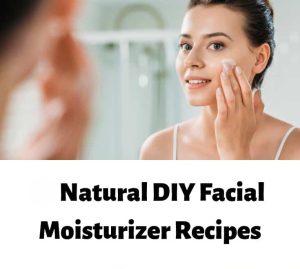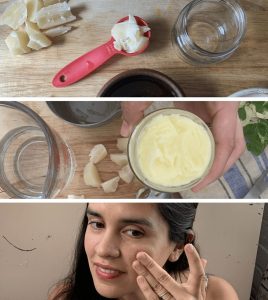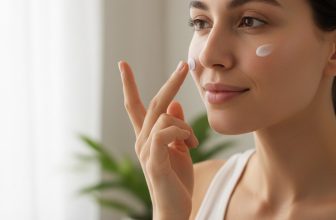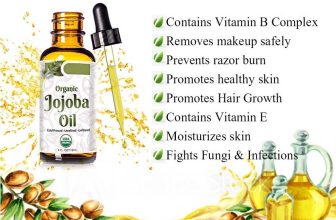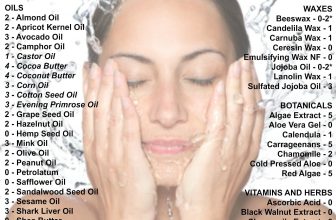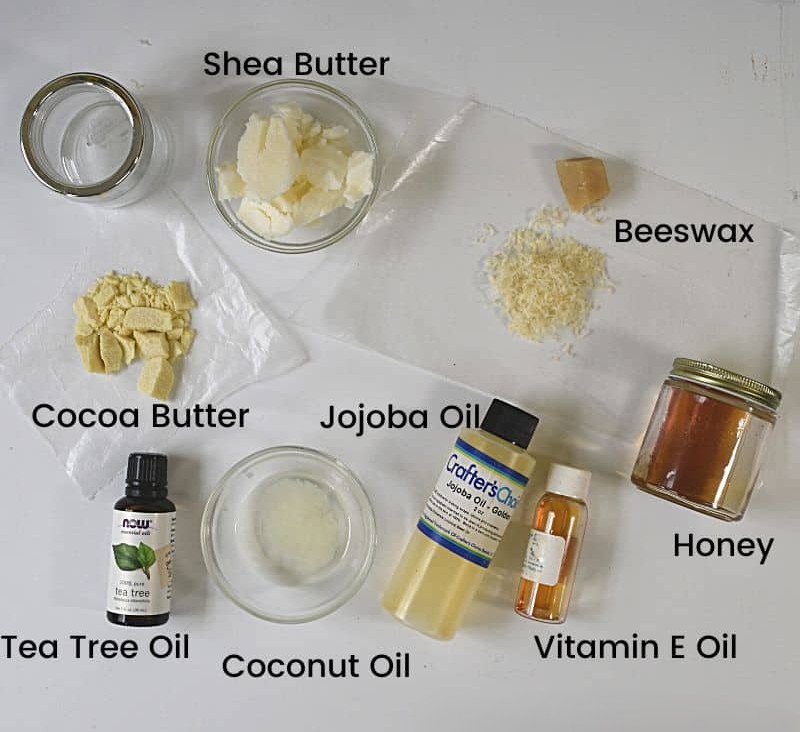
Finding the right moisturiser for your face can be a challenging task. Many products contain chemicals that can irritate your skin.
Making your own natural moisturiser at home can be a terrific idea. It’s simple to create, works well, and you know exactly what goes into it. You can use things you already have at home to make natural moisturisers. Things you use every day, like honey, olive oil, and coconut oil, work great.
They hydrate your skin without harmful additives. When you make your own moisturiser, you can tailor it to your specific skin needs. No matter what kind of skin you have—dry, oily, or sensitive—there is a recipe for you. With simple recipes and easy-to-follow steps, this blog will show you how to make your own natural lotion at home. Let’s begin and learn how to take natural care of your face!
Natural Moisturiser for Face Homemade: Glow Boosters!
Creating your own natural moisturisers is an easy way to make your skin look and feel its best. They use things you can find in your kitchen. These things can help make your skin look more hydrated, healthy, and radiant.
Creating your own moisturiser is a straightforward and enjoyable process. You can customise it to suit your skin type. Let’s explore some recipes that can help your skin glow.
Honey And Olive Oil Moisturiser
Honey is a natural way to keep things moist. It pulls moisture into your skin. Olive oil contains a variety of vitamins. Together, they create a soothing blend.
Mix
- 1 tablespoon of honey with
- 1tablespoon of olive oil.
- Apply it to your face. Leave it on for 20 minutes and rinse with warm water.
Aloe Vera And Coconut Oil Blend
Aloe vera is known for its soothing properties. It hydrates and heals the skin. Coconut oil adds moisture and shine.
Combine
- 2 tablespoons of aloe vera gel with
- 1 tablespoon of coconut oil.
- Apply this mixture to your face. Please wait 30 minutes before you rinse it off.
Yoghurt And Lemon Face Mask
Yoghurt nourishes and exfoliates the skin. Lemon brightens and tones. This mask can help achieve a natural glow.
- Mix two tablespoons of yoghurt with a few drops of lemon juice.
- Apply it to your face and leave it on for 15 minutes. Rinse with cool water.
Avocado And Honey Cream
Avocado is creamy and packed with vitamins. It nourishes dry skin. Honey adds extra hydration.
- Mix 1⁄2 an avocado with
- 1 tablespoon of honey.
- Apply the mixture to your face. Leave it on for 20 minutes, then rinse thoroughly.
Use these DIY moisturisers to make your skin seem even better. Your skin will feel and look great.
The Appeal of Natural Ingredients
Natural ingredients add a special touch to skin care. They link us to nature. Many individuals prefer them over synthetic ones. Simple, safe things are typically used in homemade moisturisers. Ingredients like honey, olive oil, and aloe vera are popular. They offer nourishment without harsh chemicals.
Choosing natural means caring for your skin gently. Each ingredient has its own benefits. They work together to calm and moisturize the skin. When you use natural products, you know exactly what you’re putting on your skin. People trust you more when you are open. You can easily find these ingredients at home or in your local store.
Benefits Of Going Natural
Natural moisturisers are friendly to the skin. They usually have fewer irritants. Many people find them soothing. Ingredients like shea butter and coconut oil help restore moisture. They also promote a healthy glow.
Using natural products can improve skin health. They often contain antioxidants. They battle free radicals and make you look younger. Natural oils help keep the skin’s barrier strong. This keeps moisture in, which keeps things supple.
The Bad Things About Synthetic Products
Synthetic items may contain substances that are harmful to you. These can irritate or dry out the skin. Many people experience allergic reactions. The skin does not readily absorb some ingredients.
Long-term use of synthetic moisturisers can lead to issues. They might disrupt the skin’s natural balance. Over time, this can cause dependence. Your skin may struggle to stay moisturised without them.
Kitchen Pantry To Beauty Shelf
Transform your kitchen pantry into a beauty shelf with a homemade natural moisturiser for your face. Simple ingredients like olive oil, honey, and yoghurt can nourish your skin. Enjoy soft, hydrated skin using easy recipes right from your home. Embrace natural beauty today.
Transform your kitchen pantry into a treasure trove of skincare. Many of the ingredients you use to cook can also be beneficial for your skin. Make your own moisturizers tailored to your skin with a bit of imagination.
Common Ingredients for Making Your Own Moisturisers
You may already have some of the things you need in your kitchen to have glowing skin. Here are some things to think about:
- Honey: Honey is a natural humectant, which means it draws in moisture and is suitable for hydration.
- Coconut Oil: This oil is rich in fatty acids, which confer it strong antimicrobial and moisturising properties.
- Olive oil is rich in antioxidants that help combat the effects of ageing and deeply nourish the skin.
- Avocado: It is creamy and full of vitamins, and it makes dry skin feel better and more alive.
- Yoghurt: Lactic acid in yoghurt helps to remove dead skin cells and keep your skin hydrated.
These simple items work better than you think. Each one has its own properties that are good for different types of skin. Have you incorporated any of them into your skincare routine?
Transforming Everyday Items Into Skincare
Think about how easy it is to create a moisturiser at home. A simple combination of honey and olive oil can yield a rich, hydrating cream.
To make it,
- mix two tablespoons of honey with
- one tablespoon of olive oil.
- Blend them well and apply them to your face for about 20 minutes. To get soft, smooth skin, wash it off with warm water.
You could also
- Mash half an avocado and add
- 1 tablespoon of yoghurt to it.
This combination offers deep hydration and revitalises your complexion.
Have you ever noticed how your skin feels after using fresh ingredients? Getting creative with your pantry items allows you to customize your skincare routine. It’s not just about moisturising; it’s about knowing what your skin needs. Why not start experimenting today and see what works best for you?
Moisturiser Recipes For Different Skin Types
Create your own natural face moisturiser at home. Different recipes suit various skin types. Use simple ingredients like honey, aloe vera, and coconut oil for hydration and nourishment. Enjoy soft, healthy skin with these easy DIY options.
Creating a natural moisturiser at home allows you to tailor your skincare routine to your unique skin type. Regardless of whether your skin is oily, dry, or a combination of both, certain substances can help you achieve the right balance. Discover these easy DIY moisturiser recipes tailored to your skin type and experience the benefits of healthy, nourished skin.
How to Deal with Oily Skin
If you have oily skin, look for lightweight ingredients that keep your skin hydrated without clogging your pores.
Aloe Vera and Jojoba Oil Moisturiser
- 2 tablespoons of aloe vera gel –
- 1 tablespoon of jojoba oil –
- A few drops of tea tree oil (optional)
Place these ingredients in a basin and mix them. After washing your face, apply a slightly thin layer to it. Aloe vera helps calm irritation, and jojoba oil mimics the natural oils in your skin, which reduces shine. Your skin will feel different—less oily and more balanced.
Dry Skin Soothers
Dry skin can be painful and typically appears lifeless. To bring back moisture and give your skin a healthy glow, use products that are rich and moisturising.
Recipe: Honey and Coconut Oil Moisturiser
- 1 tablespoon of raw honey –
- 2 tablespoons of coconut oil –
- A few drops of lavender essential oil (optional)
Mix the honey and coconut oil until they form a smooth mixture. Apply a generous amount to your face and wait 15 minutes before washing it off. Use warm water to wash. Coconut oil deeply moisturises your skin, and honey is a natural humectant that pulls water into your skin. Your skin will feel soft and smooth when it drinks up the moisture.
Balancers for combination skin
It’s not always easy to take care of combination skin. You need a moisturiser that will keep your skin hydrated without exacerbating the oily areas.
How to make: yoghurt and avocado moisturiser
- 2 tablespoons of yoghurt that isn’t flavoured
- 1/2 ripe avocado
- 1 tsp of olive oil
Mix the mashed avocado with yoghurt and olive oil until the mixture is smooth and homogeneous. Apply this mixture to your face, paying special attention to the dry areas.
The probiotics in yoghurt help keep your skin’s microbiome in balance, while the healthy fats in avocado help it grow. Your skin will feel balanced, with dry spots comforted and oily spots kept under control. Finding the proper homemade moisturiser for your skin type is not hard.
What natural things do you already have at home that could help with your skin care?
The Importance of Essential Oils
Essential oils play a crucial role in creating your own natural face moisturisers. Not only do they improve the smell, but they also benefit the skin in various ways. Some essential oils can moisturise, calm, and even help alleviate specific skin problems.
Choosing the Right Oil
It’s essential to pick the right essential oil for your skin type. Every oil has its own unique qualities that make it suitable for specific purposes. Here are some well-liked choices:
- Lavender: Good for sensitive skin because it calms and reduces inflammation.
- Tea Tree: Great for skin that is prone to acne since it kills microorganisms.
- Rosehip is excellent for dry or mature skin because it contains high levels of vitamins A and C.
- Frankincense is renowned for its ability to promote skin cell growth and its anti-ageing properties.
Think about what your skin needs. Are you struggling with dryness or blemishes? Identifying your skin concerns will help you select the right essential oil.
Safety Measures For Using Essential Oils
Using essential oils requires caution. If you don’t use them properly, they might be powerful and hurt your skin.
- Always mix essential oils with a carrier oil, such as coconut or jojoba oil, before applying them to your face.
- Perform a patch test first: Apply a small amount of the diluted oil to a less visible area of your skin. To check for any negative responses, wait a whole day. If irritation occurs, discontinue use immediately.
- Keep essential oils away from your eyes and mouth. These areas are sensitive and can react poorly.
- Always store essential oils in a cool, dark place to maintain their potency.
Have you ever experienced an adverse reaction after using an essential oil? To enjoy their benefits without risk, it’s important to know how to utilise them securely.
Herbs and spices to make you glow more
Your skin can be healthier with the help of herbs and spices. They offer natural benefits. Using them in homemade moisturisers helps your skin glow. Let’s explore two popular options.
Turmeric: The Golden Spice
Turmeric is known for its bright yellow colour. It has many healing properties. This spice fights inflammation and reduces redness. It helps even out skin tone.
Turmeric also contains antioxidants. These protect the skin from damage. Mix turmeric powder with yoghurt or honey. Apply it to your face for a natural glow.
Aloe Vera: The Herb That Calms
People are aware that aloe vera is beneficial for soothing the skin. It hydrates and cools the skin. This herb helps heal sunburns and irritation. It is perfect for sensitive skin.
Get fresh aloe vera gel right from the leaf. For optimal results, use it every day. Your skin will feel smooth and new.
Fruits And Vegetables: Vitamins For Your Skin
Fruits and vegetables are rich in vitamins. They are great for your skin. Using them in homemade moisturisers can help nourish and hydrate the skin. Natural ingredients work gently. They can improve your skin’s texture and glow.
Two of the best options are avocado and cucumber. Each has unique benefits. Let’s explore how they can boost your skin health.
Avocado: Nature’s Butter
Avocado is rich in healthy fats. It helps to hydrate dry skin. This fruit contains vitamins E and C. These vitamins fight free radicals. They keep your skin youthful and fresh.
You can make an easy avocado mask.
- Mash one ripe avocado.
- Apply it directly to your face.
- Leave it on for 15 minutes.
- Rinse with warm water. Your skin will feel soft and smooth.
Cucumber: The Hydration Expert
Cucumbers are known for their high water content. It helps keep your skin hydrated. This vegetable also contains vitamins A and K, which help soothe and refresh your skin.
For a cooling mask,
- blend a cucumber.
- Strain it to get the juice.
- Apply the juice to your face with a cotton ball.
- Let it sit for 10 minutes.
- Rinse it off for a refreshing feel.
Creating A Custom Moisturiser
Creating a natural moisturiser for your face at home is a simple and enjoyable process. Use easy ingredients like coconut oil, aloe vera, and essential oils. This DIY approach keeps your skin soft and healthy without harsh chemicals. Enjoy the benefits of a gentle, homemade blend.
It can be fun and satisfying to make your own natural lotion. You can adjust it to suit your skin’s needs, ensuring you receive the optimal amount of moisture and nutrition. Let’s explore how to create a moisturiser that works perfectly for your face.
Identifying Your Skin’s Needs
Start by understanding your skin type.
Is it dry, oily, combination, or sensitive? You can conduct a simple test. After washing your face, wait at least one hour. Observe how your skin feels. If it feels tight and flaky, you likely have dry skin. You may have oily skin if your skin appears shiny. Knowing your skin’s needs helps you choose the right ingredients.
If your skin is dry, look for oils such as almond or jojoba.
If you have oily skin, lighter oils like grapeseed or hempseed can do a lot of good.
Think about any skin problems you could have, like acne or eczema. Choosing the appropriate ingredients can help your skin feel better and be healthier overall.
Experimenting With Textures And Scents
The texture of your lotion can significantly impact how you feel.
Consider a light balm or a rich cream. If you can’t find the right consistency, mix different butters and oils. A lot of shea butter is dense, but aloe vera juice is light and pleasant. Adding smell to your routine might make it work better.
Essential oils like lavender and tea tree not only smell nice on the face, but they can also help it in other ways. Just don’t overuse them. Consider this: how does a particular scent make you feel? It can transform your skincare ritual into a moment of self-care and relaxation. Creating a custom moisturiser allows you to take charge of your skincare. The journey is all about finding what feels right for you. So, what will you create today?
Application Techniques For Maximum Absorption
Applying a natural moisturiser correctly boosts its effectiveness. The proper techniques help your skin absorb the product better. Here are some tips to ensure you get the most out of your homemade moisturiser.
Best Times To Apply
Timing is key for applying moisturiser.
- Use it right after cleansing your face. This helps lock in moisture while your skin is still damp.
Morning and evening are the best times for this.
- In the morning, it protects your skin throughout the day.
- In the evening, it nourishes your skin while you sleep.
- Consider applying it after a warm shower. The steam opens your pores. This allows the moisturiser to penetrate deeper into the skin.
Layering With Other Skincare Products
Layering can enhance the effectiveness of your moisturiser.
- Use a gentle cleanser first to remove dirt.
- Use a toner afterwards to restore your skin’s pH to normal.
- Use serums or oils before the moisturiser. These products add extra hydration.
- Wait a moment after applying each product. This allows your skin to absorb them fully.
Finish with your natural moisturiser. Use gentle, upward strokes. This technique promotes blood flow and helps absorption.
Sustainability And Zero-Waste Skincare
Sustainability in skincare is vital. It reduces waste and protects our planet. Homemade moisturisers help achieve this. They use natural ingredients and minimise packaging.
Choosing zero-waste options is easy. Simple steps can make a big difference. Let’s explore ways to reuse food scraps and pack more sustainably for the environment.
How to Use Up Kitchen Leftovers
Your kitchen has great things for your face. Your skin can be hydrated by incorporating extra herbs, vegetables, and fruits into your diet.
- For instance, overripe bananas can be used as an excellent lubricant. They have a lot of vitamins and make the skin smoother.
- Leftover avocado is another option. It adds healthy fats to your skin.
- Don’t toss out used green tea bags. They can soothe your face and reduce puffiness.
Using these leftovers cuts waste. It also saves you money. Enjoy the benefits of natural ingredients from your kitchen.
Eco-friendly Packaging Ideas
Packaging matters for zero-waste skincare. Instead of plastic, use glass jars. They are reusable and recyclable. You can repurpose small jars from food items.
Consider using metal tins as well. They last long and keep products fresh. Cloth bags can be an excellent option for storing homemade creams.
Make your skincare routine sustainable. Choose packaging that reduces waste. Every little choice helps our planet.
Troubleshooting Common Issues
Creating a natural homemade moisturiser for your face can lead to common issues. The skin may feel oily or not absorb the cream well. Identifying these issues helps you adjust the ingredients to achieve better results. Making a few minor adjustments to your homemade lotion can improve its effectiveness.
Resolving common issues with your homemade natural lotion can save you time and help you achieve the skin you desire. It’s essential to know how to handle problems like unexpected breakouts or recipe changes that occur with the seasons. Here’s how to address some of the more common issues.
Handling Breakouts
Breakouts can depress you after making a homemade moisturiser. Consider your ingredients if your skin reacts poorly to them.
Essential oils can block pores. Try jojoba or grapeseed oil instead of coconut or olive oil.
Test before applying: Before using new products on your face, test a small area first to ensure you’re not allergic to the ingredients.
Change Your Recipe: Reduce heavy ingredients if outbreaks increase. A simple blend of aloe vera gel and a few drops of essential oil is often more suitable for your skin type. Reflect on your skin’s response to your moisturiser. Have you made any changes recently?
Adjusting For Seasonal Changes
Your skin’s needs change with the seasons. In the winter, what worked well in the summer might not be enough. –
Levels of Humidity: The air is drier in the winter. To retain moisture, consider adding a thicker foundation, such as shea butter, to your routine.
Temperature changes: Your skin may feel tight or flaky when transitioning from a hot to a cold environment. Look for things like honey, which can help keep your skin moist. –
Changes to the routine: Feel free to change your skincare routine. In the spring and summer, a lighter moisturiser can be just what you need. In the fall and winter, though, you need a more decadent blend.
Have you noticed any changes in your skin as the seasons have changed? Changing your moisturiser can have a significant effect on how your skin looks and feels. You can enhance your homemade natural moisturiser and enjoy healthy, glowing skin all year round by addressing these common issues.
Embracing A Natural Skincare Routine
A natural skincare program can transform your skin. Select items that are free from harsh chemicals and rich in nutrients. Making your own natural moisturiser at home lets you control what goes on your face and learn more about your skin.
Using Moisturisers Daily
- Start your day clean-faced.
- Apply homemade moisturiser while the skin is damp after washing. This helps lock in hydration.
- Choose a time that works for you. Morning and night are ideal.
- Consistency is key, so make it part of your daily routine.
Consider using your natural moisturiser as a base for makeup. It makes your skin smooth and keeps it healthy throughout the day.
Natural skin care offers lasting benefits.
Over time, using natural moisturisers can make your skin healthier. You might see fewer breakouts and a more even skin tone.
Many natural compounds can help with inflammation. They can soothe irritation and reduce redness, making your skin look radiant.
Consider the long-term benefits as well. Making your own products can be more economical than buying commercial skincare items.
What changes have you noticed in your skin since switching to natural products? Your journey with natural skincare can inspire others to make the switch.
Frequently Asked Questions
How can I naturally keep my face moist at home?
Coconut oil, olive oil, and aloe vera are all natural ways to keep your face moist at home. Use honey or yogurt to keep your skin moist. Incorporate avocado masks for added nourishment. Stay hydrated by drinking plenty of water. Regularly use these methods to maintain soft, healthy skin.
What Is A 3 Ingredient Diy Moisturiser?
A 3-ingredient DIY moisturiser typically includes natural oils, butters, and essential oils. Common combinations are coconut oil, shea butter, and lavender oil. This simple blend effectively hydrates and nourishes the skin. Customise it by adding your favourite scents or oils for a personalised touch.
How can I keep my face moist at home?
Use a gentle wash and a moisturising toner to keep your face hydrated at home. Use a thick moisturiser that is right for your face. Use a product that moisturises and contains hyaluronic acid. To keep the air moist, drink a lot of water and use a fan.
Can you put coconut oil on your face to feel better?
Yes, coconut oil can help keep your face soft and smooth. It effectively hydrates and nourishes the skin. Its natural properties help to lock in moisture. However, it’s best for dry skin types. Those with oily skin should use it cautiously to avoid breakouts.
What Is A Natural Moisturiser for The Face?
A natural moisturiser for the face is a cream or lotion made from plant-based ingredients. It helps hydrate and nourish the skin without harmful chemicals.
Conclusion
Creating a natural moisturiser at home is a rewarding and straightforward process. You can use ingredients from your kitchen. These moisturisers are gentle on your skin. They are free from harsh chemicals. Try out different recipes until you find the one that you like the most.
If you use it regularly, your skin will get soft and hydrated. If you add something new, don’t forget to patch test it first. Not only do homemade lotions work well, but they are also cheap. Enjoy the natural process of caring for your skin. Your face will thank you for it.

